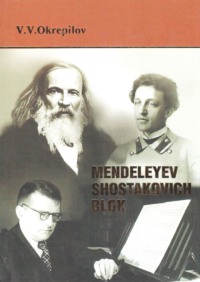
Mendeleyev. Shostakovich. Blok
The attempt to construct the molecular mechanics is very interesting. It is an example of the orientation of the scientist’s works to the significant theoretical generalizations. Though today this idea is only of a historical importance, nevertheless, it describes perfectly the independent approach of the scientist to the solution of the problems of the substance structure. In the middle of the 19th century it hadn’t been generally acknowledged yet and it had been supported only by individual scientists in different countries. The molecular theory started to be generally acknowledged only after the International chemical congress in Carlsruhe in 1860.
Participation in the International chemical congress, which took place on September, 3rd-5th of 1860, became for Mendeleyev one of the most bright events of that year, which influenced greatly upon his choice of scientific interests during the following years. Mendeleyev came to the congress as a member of the delegation of Russian chemists, where were N. N. Zinin, A. P. Borodin, L. P. Shishkov, etc. During the congress’s work Dmitry Mendeleyev got acquainted with many prominent scientists of Europe. Those were J.– B. Dumas, Ch. Wurza and S. Cannizzaro, G. Rosko, etc. He continued communicating with them later.
It is difficult to overestimate the meaning of the International chemical congress in the history of chemistry. There was accepted the common system of atomic weights and were defined the conceptions of the molecule and atom.
As stated above, the scientific conceptions, which had been generally acknowledged at the congress of 1860, appeared in Mendeleyev’s research even before; the fundamentals of the molecular theory, as well as the principles of defining the molecular weight and density, were delivered by him at his lectures.
At the beginning of the 1860’s another important event took place in the life of D. I. Mendeleyev. On April, 29th of 1862 there was a wedding of Dmitry Mendeleyev and Theozva Nikitichna Leshchova, the stepdaughter of Pyotr Petrovich Ershov, the authour of the fairy-tale “Konyok-Gorbunok” (“The gibbous horse”). The wife was six years older than her husband. Their first-born son was Volodya, then daughter Olga was born. But this marriage wasn’t a happy one. Active work of a scientist, his uneasy way of life appeared to be far from the supposed ideal of wife. Interests and characters of this married couple were too different. At the beginning of the 1870’s their relationships started being complicated. Theozva Nikitichna gave her husband absolute freedom under the condition that the official marriage wouldn’t have been annulled.
In spite of the difficult relationships with his wife, D. I. Mendeleyev always behaved towards the family very carefully and responsibly. Especially he loved children, he often said, “Whatever I do and, however, I’m busy, I’m always happy when any of them comes to me.” The only thing, which could interrupt his work, were the children. If he suddenly heard the children’s screaming or crying, right away he rushed to find out what had happened. He used to come running and frightened, screamed loudly and threateningly, but in no circumstances at the child, but at the nunny. The nunny experienced it almost always and the children – never. Dmitry Ivanovich said, “I experienced many things in my life, but I don’t know the better happiness than to see my children next to me.”
His niece Nadezhda Yakovlevna Kapustina-Gubkina remembered that he loved and worried not only about his own children. In Boblovo – the estate purchased by D. I. Mendeleyev in 1865 on an equal footing with his friend N. P. Ilyin – in summer there were having rest several families with their children. The kids were always around the master of the house, they used to walk with him on his household business. It was interesting for them to listen to the stories of Dmitry Ivanovich, to walk with him about the forest, to share with him their joys and sorrows.
N. Y. Kapustina-Gubkina remembered an episode, which had vividly illustrated Dmitry Ivanovich’s delicacy towards the child’s soul, his kindness, “In the morning my elder brother and sister were teaching us in Russian and in French. I perplexed in my translation and my sister was keeping me for a long time under the lesson. Dmitry Ivanovich was passing by the sitting-room, where we were studying, and told my sister casually:
– Why are you exhausting her over the book, Anyuta? Let her walk, she will have time.
Right away I ran away, but after forty years I remember how kind he was towards the child’s soul.”
D. I. Mendeleyev is a scientist, a teacher, a public figure
The 1860’s became for Dmitry Ivanovich Mendeleyev the time of realization of the significant research of scientific and applied nature. Here the amazing correlation of theoretical works of the scientist and their practical application became apparent.
Later his son Ivan Dmitrievich Mendeleyev wrote about his father, “I knew as though two Mendeleyevs. One of them was an assiduous collector of facts, a petty empiricist – Wagner of Goethe, for whom the highest pleasure was the treatment of the number, piling of the data, examination of interesting individual features of the phenomena. Another one was the valorous Faust, passing away to the “spirits’ world”, to the world of ideas, to the world of general laws…”
In 1861, at the suggestion of the “Public Good” Publishing House, D. I. Mendeleyev wrote a manual of organic chemistry, which became the first Russian textbook on this subject. The basis of this manual was the series of lectures delivered by him in 1857–1858. The book was written during the extremely short term and it caused the broad response in the scientific and public groups. Mendeleyev was awarded to a prize of the Academy of Sciences, and in 1863 the second edition of the manual was published.
Mendeleyev also started to edit the Technical Encyclopedia in many volumes “Technologies according to Wagner” (Wagner J.– R. Theorie und Praxis der Gewerbe: Hand und Lehrhuch der Technologie). Wagner’s Encyclopedia was published in Leipzig in 1857–1860 and had a great success in Europe. First, D. I. Mendeleyev decided to make a translation only because of the lack of money. He remembered, “I started translating and completing the “Technologies according to Wagner” because it was paid (30 rubles per sheet), but then I was interested and made many additions…”
The work on editing this book took several years. Dmitry Ivanovich not just translated the “Technologies…” from German, but he made a large amount of adjustments, sometimes completing the book with his own chapters. After all, the “Technologies according to Wagner” played a significant role in the choice of the future subject of the scientist’s research. In the third part of the “Technologies…” there were discussed the scientific and technological problems, connected with alcohol production. The practical importance of precise data about the density of alcohol-aqueous solutions and theoretical meaning of these data combined in this question. Density had been always considered by D. I. Mendeleyev as the most important parameter of substance. By the middle of the 1860’s the scientist started paying less attention to the edition of the “Technologies according to Wagner” and was more and more concentrated on the research of the alcohol-aqueous solutions.
In 1863, in connection with the development of the technology of alcohol-aqueous industry, Mendeleyev started a new big series of science works on this subject. On the first stage he was constructing the instruments for defining alcohol concentration – alcoholometers. And on the next stage – the thorough research of relative density of alcohol-aqueous solutions in the whole interval of concentrations under several temperatures. This experimental work became the foundation of the Doctoral thesis, which was presented by him to the Council of Petersburg University at the end of 1864 and was defended by him in 1865.
The research “About the connection of alcohol with water” contains the basic regulations of Mendeleyev’s doctrine of the solutions and it especially determines the existence of water and alcohol connections. Here are the results of measuring the density of aqueous solutions of ethyl alcohol with 35 to 100 % of alcohol according to weight under five values of temperature (0°, 10°, 15°, 20° and 30 °C).
It is necessary to thank Dmitry Ivanovich Mendeleyev that Russia was possible to give the world its famous Russian vodka. V. Pohlebkin in his article, devoted to the Mendeleyev’s research, wrote, “D. I. Mendeleyev, who had taken part in his time in the creation of the contemporary scientific technology of vodka production, insisted definitely on making the general official name “vodka” as the most exactly expressing the character of the drink.
Till the establishment of the vodka monopoly in 1894–1902, vodka had been produced very easily – by mixing up 50 % of alcohol with 50 % of water. Such a mixture gave 41–42° of alcohol in the drink. In order to get the forty-degree vodka, it was necessary not to combine volumes but to weigh alcohol precisely. Mendeleyev proved that 40°, which is indeed never got by mixing up the volumes of the water and alcohol, but only by mixing up the precise weight ratio of alcohol and water, should have been acknowledged as the ideal content of alcohol in vodka.
Thus, one litre of forty-degree vodka should weigh exactly 953 g. The alcoholic content of the alcohol-aqueous mixture, weighing 951 g, will be 41°, and it will be 39° in case of weighing 954 g. The physiological influence of such a mixture to organism becomes worse in both cases and, definitely speaking, both of them cannot be called vodka.

Densimeters constructed by D. I. Mendeleyev. Made in 1859-1860

Young Russian scientists-chemists. From left to right: N. Zhitinsky, D. I. Mendeleyev, A. P. Borodin, V. I. Olevinsky, I. O. Heidelberg. 1860
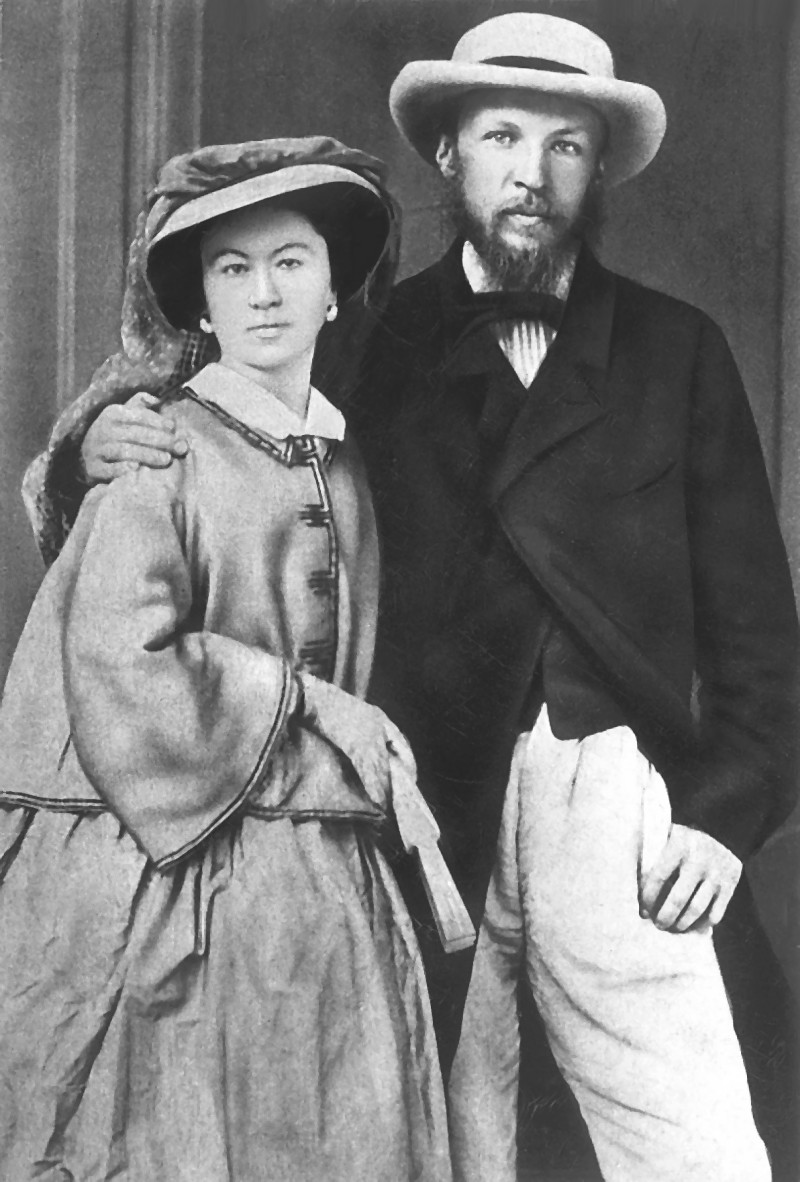
Dmitry Ivanovich Mendeleyev and Theozva Nikitichna Mendeleyeva (nee Leshchova; 1828–1905) – the first wife of D. I. Mendeleyev. 1862
As a result of the research of D. I. Mendeleyev, since the end of the 19th century only product containing grain alcohol mixed by water according to weight exactly till 40°, could have been regarded as Russian (or rather – “Moscow”) vodka. This Mendeleyev’s structure of vodka was patented in 1894 by the government of Russia as Russian national vodka – “Moscow Especial” (first it was named “Moscow Particular”).
As during the life of D. I. Mendeleyev his data were started to be used for the wine-making calculations in Austria, Germany and Holland.
In Imperial Russia the alcoholometrical tables were based on the archaic English and German data. The results of D. I. Mendeleyev were admitted later. In the 1920’s the special commission of the Principle Board of Weights and Measures came to a conclusion that the work of Mendeleyev was precise to the maximum. In 1927 new alcoholometrical tables, the basis of which were the results of the scientist’s research, were published.
From the very graduating the Main Pedagogical Institute, teaching took a considerable time of Dmitry Ivanovich Mendeleyev. Teacher’s work of the scientist amazes by its breadth. At first, together with general, theoretical, organic and analytical chemistry he was teaching physics and physical geography. Students not just loved the scientist, they literally worshipped him. His appearance also made a great impression. He had never delivered his lectures smoothly, but always vividly, interestingly and informally, accompanying his words with an expressive mimicry. It was difficult to take exams to him.
Dmitry Ivanovich was teaching at the University, the Institute of Technology, the Institute of the Corps of Engineers of Communications, at the Nicholas Engineering Academy, the Nicholas Engineering School and at the 2nd Military School. Since 1871 he had been teaching chemistry at the Higher Female Courses. Later the number of the educational institutions, where Mendeleyev had been teaching, slightly reduced and he concentrated all his work mainly at the Institute of Technology and at the University.
Mendeleyev wasn’t only teaching but he always took part in the public life of the educational institutions, quickly reacting to the changes, which had been made in the system of Russian education. The liberal reforms of the 1860’s, which had been made by Alexander II, applied to the system of education in Russia and influenced the life of the University immediately. The statute of the University, signed by Alexander II on June, 18th of 1863, was the most liberal university regulation in Russia of the 19th – the beginning of the 20th century. The statute gave autonomy to the higher educational institution. The University’s board, the members of which were all the professors, became an independent institution. The Board had the right to choose the rector, pro-rector, deans and also professors for the vacant chairs. It was very important that the University’s board got an opportunity to divide the faculties to the branches, to join and to divide the chairs, to change them and to define which subjects should have been considered obligatory and not obligatory for students.
Having become in 1867 the head of the department of general chemistry of the physico-mathematical faculty, Mendeleyev succeeded to separate out an independent course of analytical chemistry, which had been taught by N. A. Menshutkin. Thanks to Mendeleyev’s initiative, A. M. Butlerov was invited to teach the course of organic chemistry from Kazan University in 1868. And since 1869 the chemical sciences were represented at the University by the three departments: of general and inorganic chemistry (D. I. Mendeleyev), of organic chemistry (A. M. Butlerov) and of analytical and technical chemistry (N. A. Menshutkin).
According to the Statute of 1863 the University got the right to establish scientific societies. Thus, Saint-Petersburg Society of Naturalists (1868), the Philological Society (1869) and the Physical Society (1872) appeared.
During these years D. I. Mendeleyev took an active part in the establishment of the scientific chemical society. There are notes in the diaries of the scientist of 1861–1862 about the meetings of the chemists which had become regular. At those meetings there were the majority of well-known chemists and representatives of the adjoining sciences, who worked in Saint-Petersburg. N. N. Zinin, F. F. Beilstein, L. N. Shishkov, A. A. Voskresensky, N. I. Koksharov, E. H. Lenz, B. S. Jacobi, etc. can be mentioned among them. It becomes clear from the diaries to what a great extent was the role of Mendeleyev in the establishment of the scientific chemical society. However, the dream of the scientist was realized only in 1868.
The work at the manual “The fundamentals of chemistry” takes an exclusive place in the life and activities of Dmitry Ivanovich Mendeleyev at the end of the 1860’s. Right this work led the scientist to the discovery of the periodical law of chemical elements. Mendeleyev must have started to work at the text of the manual in winter of 1867–1868, using in the process of the work the stenograms of his lectures, made by the students. The book was published in separate editions, the first of which appeared at the end of May – beginning of June of 1868. Later Dmitry Ivanovich admitted that “The Fundamentals…” was his “dear child.”
During the process of the work at the schedule of the editions of the 2nd part Mendeleyev was gradually coming from grouping the elements according to their valency to their location according to the resemblance of their characteristics and atomic weight. In the middle of February of 1869 Mendeleyev, while keeping thinking over the structure of the subsequent chapters of the book, reached in real earnest the problem of creating the rational system of chemical elements. The determining stage came on February, 17th.

Anna Ivanovna Mendeleyeva (nee Popova; 1860–1942) – the second wife of D. I. Mendeleyev. Late 1870’s

Portrait of D. I. Mendeleyev made by A. I. Mendeleyeva. Oil, 1886

D. I. Mendeleyev. 1861
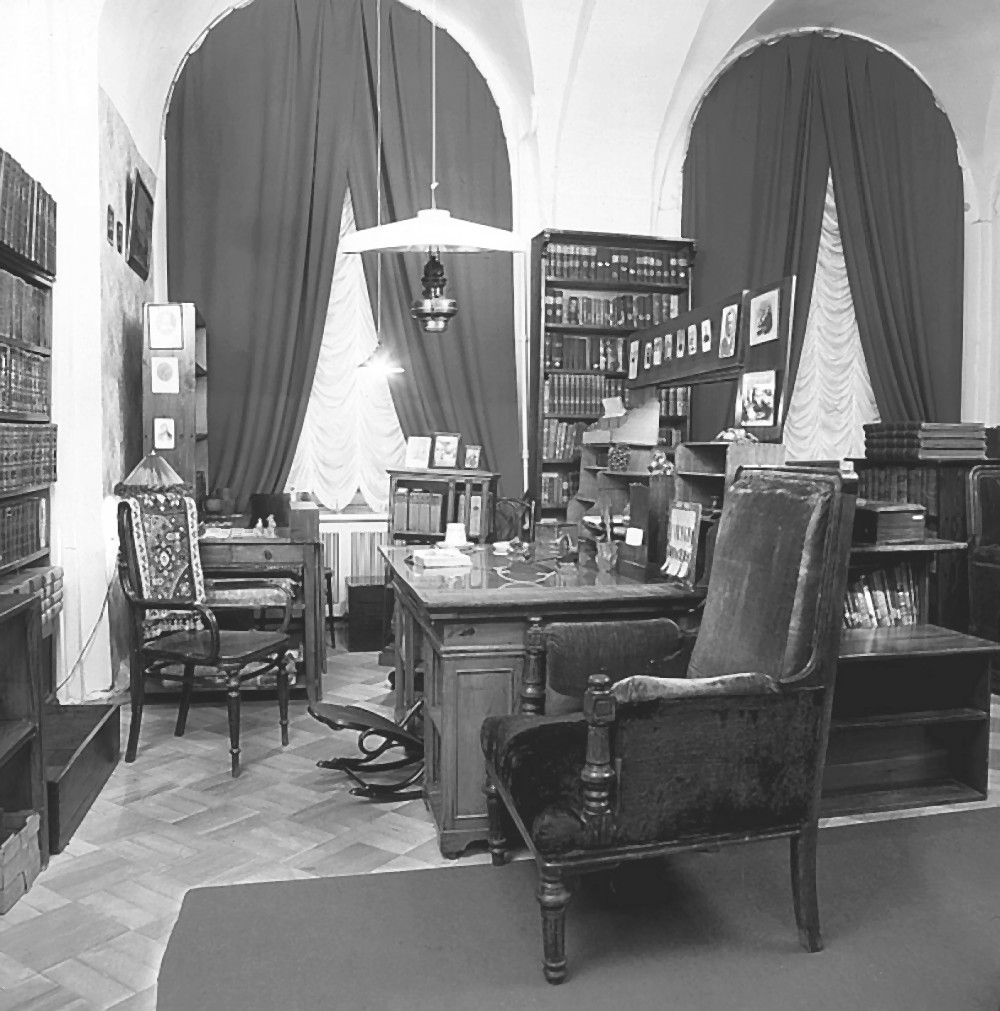
The memorial study of D. I. Mendeleyev. Restored and opened for visitors in December of 1911. (now the D. I. Mendeleyev Museum and Archives attached to SPbSU)

The desktop of D. I. Mendeleyev in his study at the University
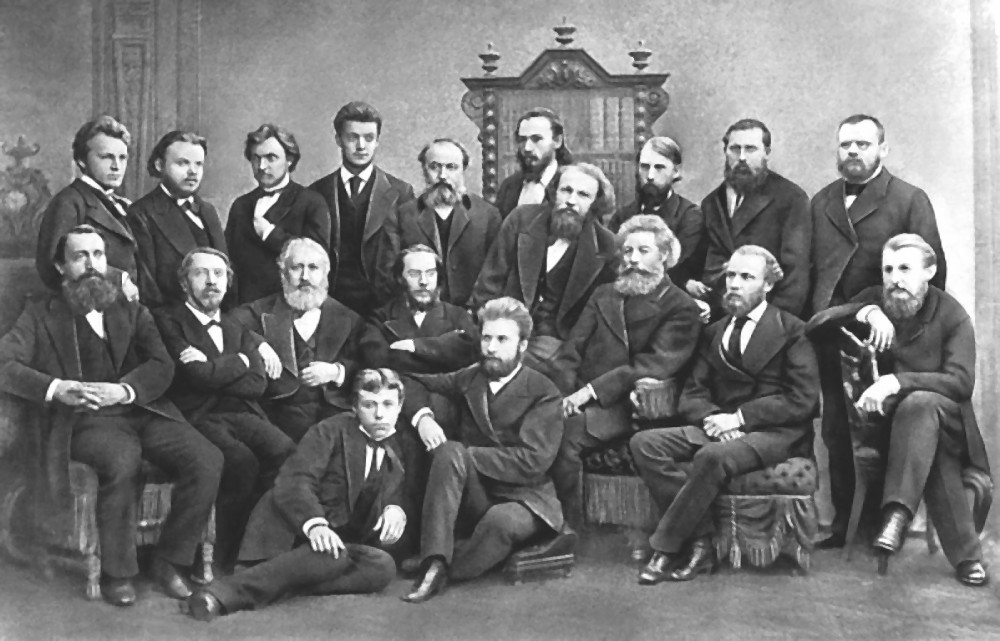
D. I. Mendeleyev (in the centre) among the professors, lecturers and students of the physico-mathematical faculty of Saint-Petersburg University. 1875

The manuscript of the table “The experience of the system of elements, based on their atomic weight and chemical resemblance.” February, 17 th of 1869
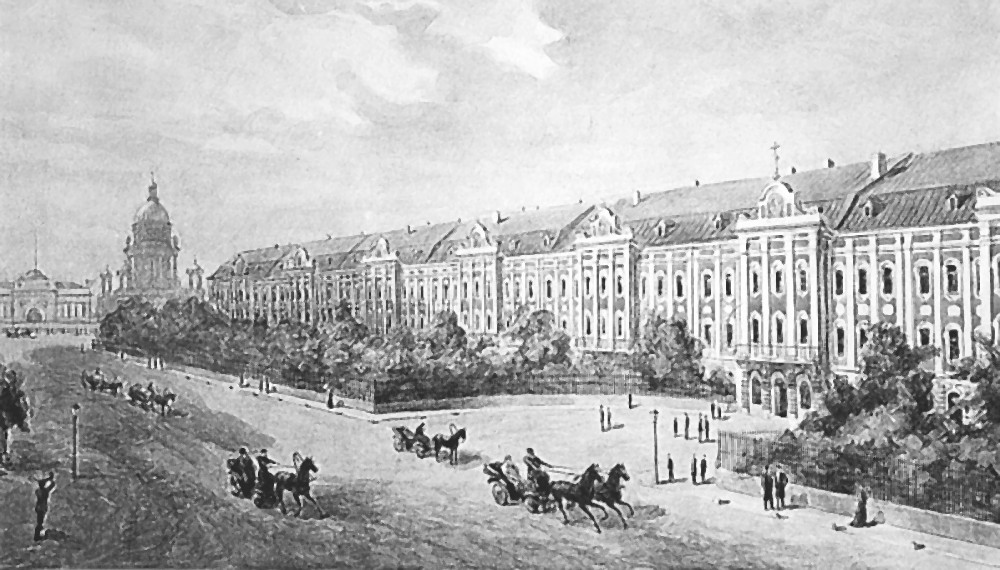
Saint-Petersburg University in the latter half of the 19th century. Water-colour by N. B. Belyavsky after the old engraving. Here D. I. Mendeleyev had been studying at the Main Pedagogical Institute (1850–1855), teaching (1857–1890) and living (1866–1890)
The scientist had been working when in the morning he was given a letter with the information about the supposed urgent trip to Tverskaya province. After having read the letter rapidly, he put the letter aside and kept comparing the different variants of comparing the elements of the natural groups according to their atomic weights. The papers cut into cards finished. A group of columns and lines, which became the starting point of the development of the table “The experience of the system of elements, based on their atomic weights and chemical resemblance”, appeared on the back side of the received letter. During the day Mendeleyev was working over the compilation of “The experience of the system of elements…” In the evening he sent a clean copy of the table to the press having made the notes for the typesetters and having written the date “February, 17th of 1869.”
There is a version that Mendeleyev saw “the system of elements” in his dream. He got up from a joyful excitement and wrote rapidly the table on a piece of paper. That’s all. The scientist compiled a clear and harmonious building of the periodical system from the chaos of separate indigested chemical elements.
Dmitry Ivanovich utterly disliked talking with the strangers “about personal, subjective part of his feelings, about the preparatory period, when the ideas had been formulating and confidence that he had reached the one of the deepest mysteries of nature had been composed little by little.” However, according to the testimonies of Ivan, his son in a second marriage, the scientist used to say that the year of 1860 had become for him the “determinative moment” in the establishment of the periodical system – the congress of chemists in Carlsruhe. And more specifically – the ideas expressed by Italian chemist S. Cannizzaro. D. I. Mendeleyev said, “I consider him to be my real forerunner, because the atomic weights defined by him gave me the necessary point of support.”
In August of 1869, at the Second congress of Russian naturalists the scientist made a report “About the atomic volume of the simple substances”, where he offered a short form of the table. Only In, the rare earth elements and several heavy ones: Au, Hg, Te, Bi, Th, U, didn’t get any place there or were located incorrectly. The scientist kept working at the allocation of these elements.
D. I. Mendeleyev was writing about the 1870’s, “This was a transitional time for me: many things had been changing in me then; I used to read a lot about religions, sects, philosophy and economical articles then.”
At that time the aggressive extremist forces of the society livened up. Mendeleyev showed himself as an active public figure, longing for contributing to the salvation of the social problems of the country. Regarding it the article of the scientist, which had been written by him for the newspaper “Voice” in connection with the appeal of the government to Russian people calling for help in the struggle with extremism, but hadn’t been published, is deserving attention. It was called “Response to the call.” The scientist disputes against the “secret arrangements” of the government – secret investigations, prohibitions to read the “rebellious” literature, etc.
The growth of interest of the scientist to history, philosophy and literature contemporizes with the growth of activity in the socio-political sphere. However, Mendeleyev’s “disposition to painting was coming out clearer than anything else.” According to the testimonies of the contemporaries, he was “not a bad graphic artist.” The Wanderers appeared to be closer to Dmitry Ivanovich than other different art schools. Namely their creativity corresponded with his realistic cast of mind.
Mendeleyev enjoyed travelling very much. During his foreign trips he had studied the main art galleries of the world. It becomes evident at the sight of his photograph albums and engravings. He didn’t miss any art exhibition in Russia. The albums, made by Dmitry Ivanovich during the exhibitions of the painters-Wanderers, are of a special interest. Thus, for instance, in the archive of the scientist there was kept an album of photocopies mainly from the 6th exhibition of 1878.
Since 1878 meetings of painters and scientists, which were named later the “Mendeleyev’s Wednesdays”, started taking place at Mendeleyev’s apartment: “There were constantly present all the Wanderers – Kramskoy, Repin, Yaroshenko, Myasoedov, Kuznetsov, Savitzky, Vl. Makovsky, P. K. Klodt, Maksimov, the Vasnetsovs, Surikov, Shishkin, Quindji, Kiselev, Ostrouhov, Volkov, Pozen, Lemoch, Prahov and Mihaltseva. Among the University professors there were more often than others Beketov, Menshutkin, Petrushevsky, Inostrantsev, Wagner, Voyeikov and Kraevich… They came to the “Wednesdays” without any special invitations.”
The “Wednesdays” were the continuation of those scientists’ meetings, the organization of which had been done by Dmitry Ivanovich during the previous years. Partly the establishment of the Association of the mobile exhibitions became an impulse for organizing the “Wednesdays.”
The scientist was interested in photography and took the most active part in organizing the photographic reproduction of the paintings and in developing the corresponding equipment. At the end of the 1870’s together with some painters and amateurs in photography he organized a group, the goal of which was the “use of photography in spreading the works of Russian art.” The group, which had been gathering at Mendeleyev’s apartment, joined the well-known Russian photographers: S. and L. Levitskies, V. Karrik, the inventor L. Varnerke, the young scientist V. I. Sreznevsky, etc. Namely here the idea of establishing in Petersburg the society of photography was born.
Except photographs and engravings, Dmitry Ivanovich was gathering valuable collections of art originals: drawings of Bruni, Ivanov, Fedotov, Repin, Quindji, Yaroshenko and Shishkin.
The painting of Quindji “Night at the Dnieper” not only made a great impression upon Mendeleyev, but also made him think about the questions of the theory of art. On November, 13th of 1900 in the 314th issue of the “Voice” was published his small article “Before the painting of Quindji.”
Mendeleyev wrote about a certain parallelism of the development of nature sciences and of the interest of artists for scenery: “They started studying nature, the natural science, which hadn’t been known in the ancient times and during the era of the Renaissance, was born… The nature became not a slave, a frame, but a helpmate, equal with man, a wife for a husband… The inductive, experimental sciences using the knowledge of external and internal, reconciling the kingly metaphysics and mathematics with the humble observation and with a request for an answer to the nature, became the crown of knowledge… At the same time with this change in the system of knowledge – if not earlier – the scenery was born.”